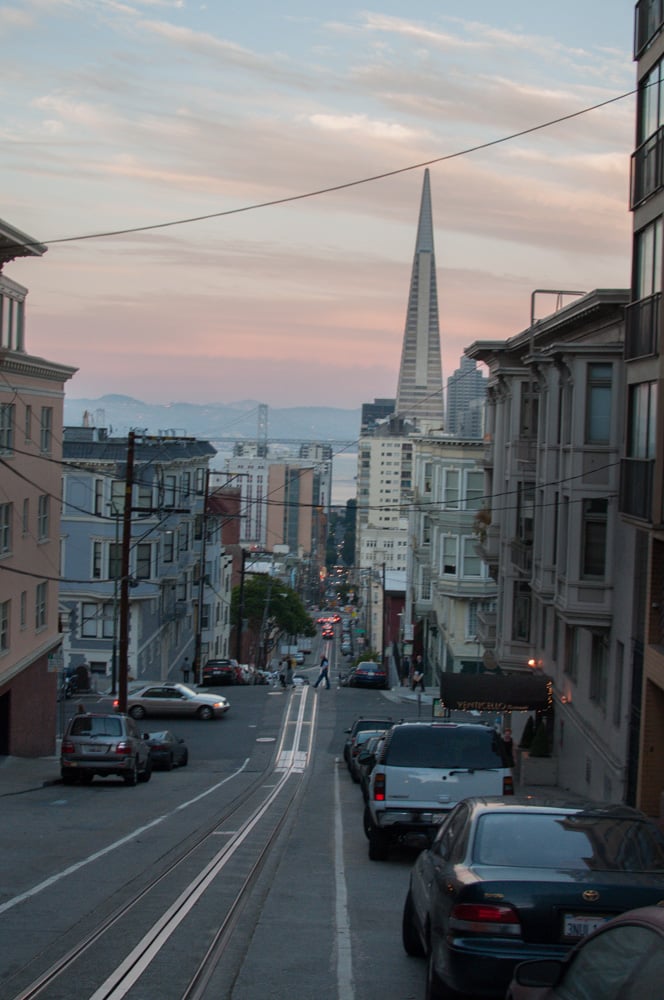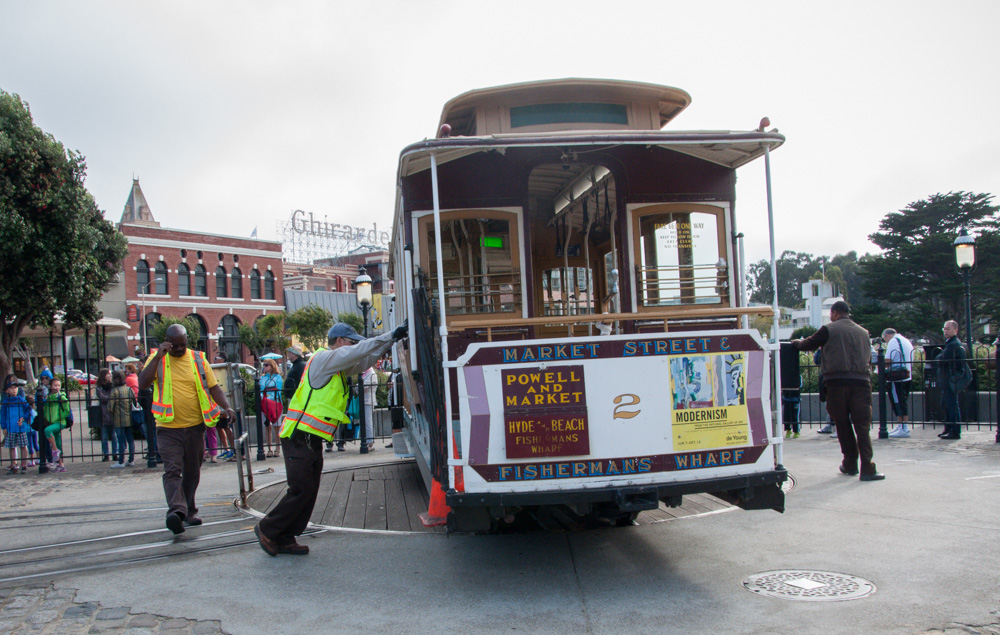Cable Car in San Francisco – “High on a hill, it calls to me / To be where little cable cars climb halfway to the stars”
Like Tony Bennett sang, there’s something about those little cable cars that transcends this world. San Francisco’s classic transportation system, cable car in San Francisco are an important symbol of the city. They are a functional attraction – there aren’t many opportunities to take a ride on something listed on the National Register of Historic Places. They’re not the most efficient way of getting around San Francisco nowadays, with the long lines to board and 9.5 mile per hour max speeds, but they are convenient for visitors getting around some of the touristy parts of town, and they sure can be fun.
Born out of necessity to combat the ultra-steep streets of San Francisco, the cable car was inspired by a tragic accident, when horses struggling to pull wagons up a hill were dragged down the hill to their deaths. One witness to the accident was Andrew Smith Hallidie, whose background made him the hero that San Francisco deserved to solve the issue. The son of the patent-holder to wire cables and himself an inventor who created a wire rope system for hauling ore from the mines as well as a bridge designer, Hallidie combined these skills to create the cable car system in 1873.
Features of the Cable Car
His patented system involved wire cables installed below the streets, continuously moving in a closed loop around a system of pulleys. The cars are controlled by drivers known as gripmen, who use a vice-like grip that slides between a crack in the street to clamp onto the cables and allow the car to be pulled along the moving cable. The gripmen release the grip on the cable to slow down, and use the brakes to stop. The system proved effective in navigating the super steep hills, catching on with other developers who made innovations of their own, and there were soon 23 cable car lines around San Francisco totaling 53 miles of track.
After the 1906 earthquake and fire destroyed much of the city, only a few of the cable car lines were rebuilt. By then, the electric streetcars had improved and could get the job done for much cheaper.
Today, three lines remain, and they’re the last manually operated cable cars in the world. Two types of cars are in use. The Powell street cars, used on the Powell-Hyde and Powell-Mason lines, are manually turned around at turntables on either end of the line. The California street car which has controls at both ends, so instead of turning the car around, the operator moves from one end to the opposite.
The Powell-Hyde line is popular among tourists, with service running from near Fisherman’s Wharf and Ghirardelli Square, past Lombard, Chinatown, and Union Square, ending near Market Street. It’s also popular because at its ends, you can watch the workers push the cars into place on the turntables, then swing them around. This also means that the lines at either end of the line are very long on weekends and during the summer, with waits upwards of an hour (and you could walk to your destination in the amount of time it takes just to board). The California line is busy on weekdays with commuters traveling through the Financial District. So is it worth the wait?
The type of ride you get is highly dependent on the gripman. On my first trip, the gripman was gruff and disgruntled. At first, he seemed like he would be fun when he rang out a minute-long cadence on the bell as we pulled out of the station, and people in the line applauded his musical efforts (give them a break, they’d been in line a long time and were thirsty for any excitement). As we traveled, however, he ignored everyone’s questions, including those that wondered where they should get off for their hotel, and he repeatedly nearly rear-ended and t-boned cars in front of us. Maybe he was just having a long day, but his grumpy mood soured the trip.
Fortunately, my next trip was much better. It was on the same route, and the line was almost as long. While we waited, a musician performed classic rock songs on his guitar and made the wait a little less boring (and props to him for knowing enough songs to not repeat any, as his captive audience was there for over an hour). He took a brief break while another street performer got our attention. I watched the fear creep over the faces of those around me in line as the man in a terrifying mask, an orange prison-issue jumpsuit, and a strait jacket tinkering with a heavy chain and padlock as he prepared to start his show. The uniform and inability to see his face was disconcerting until he began his performance and joked around, and he sounded like a regular guy who sometimes gets chained to a pole and escapes for tips. San Francisco!
We finally boarded the cable car and got a prime location near the front of the car. The gripman was fun, interacting with the passengers, hamming it up, and stopping at all the great sights along the way, to be sure that we got all the photos we wanted of the Golden Gate Bridge, Lombard and Coit Tower, the Bay Bridge, the Transamerica Pyramid, and Union Square. He pretended we were out of control as we flew down the steep hills (“No brakes!”). He warned us to watch our toes as we rode right past a row of yellow road dividers (much appreciated).
Standing on the runners rather than standing inside or sitting anywhere made a big difference in my enjoyment of the experience. People are laughing, the wind blowing through their hair, snapping photos. Gripping tightly to the poles, wondering how much it would hurt if my hands slipped and whether I could land on my feet, and the cars moving right alongside, inches away, the ride is an adventure. It’s like a 9.5 mph rollercoaster through the city, with no seatbelts, and I’m amazed that we don’t have to sign a waiver to ride. I wondered how many people had fallen off a cable car, and later looked into it and found that cable cars are involved in an average of one accident per month, making them one of the most accident-prone modes of mass transportation. The injuries were minor when people fell off the car, but more serious when the emergency brakes are used or collisions occur.
When we arrived at the final stop, I thanked the gripman for the ride and he invited me to ring the bell(!). I pulled the cord timidly and he goaded me into really going for it. He brought me around to the gripman-only area between the benches and posed for photos with me at the grip. He really made the experience great, and I can only hope there are more gripmen like him than that other guy.
As an aside, I noticed that all the gripmen I saw were men and wondered if there had ever been a woman. Operating a cable car is a physically demanding job that requires a lot of upper body strength (cable cars weigh about 8 tons with no passengers), so most of the people who take on the position are men. There have, however, been a few gripwomen to operate the cable cars of San Francisco! The first was Fannie Barnes, who took on the job in 1997. It was about time.
The cable car in San Francisco have persisted as an important part of San Francisco’s cultural heritage for well over a century and remain one of the top attractions in the city, so step on up, hang on tight, and enjoy the ride and the views on the cable cars of San Francisco.
Nearby Restaurants– Tonga Room & Hurricane Bar, Stella Pastry and Café, Mama’s – Restaurant, Rose Pistola Restaurant
Nearby Tourist Attractions– Ferry building, San Francisco Opera, Lombard street, North beach garage, SHN Orpheum



